|
|
|
Sort Order |
|
|
|
Items / Page
|
|
|
|
|
|
|
| Srl | Item |
| 1 |
ID:
116068
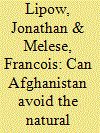

|
|
|
|
|
| Publication |
2012.
|
| Summary/Abstract |
Recent discoveries of significant mineral deposits offer Afghanistan the opportunity to attain a level of economic development sufficient to stabilize that country's volatile security situation while providing Afghans with a reasonable standard of living. Much, however, depends on whether Afghanistan can avoid the "Natural Resource Curse," an inter-related set of economic and social pathologies that often bedevil resource-endowed countries. In this article, the authors describe the Natural Resource Curse, evaluate the obstacles it raises for Afghan economic development, and offer a strategy to minimize the risks Afghanistan faces in its efforts to exploit its mineral wealth for the benefit of the population.
|
|
|
|
|
|
|
|
|
|
|
|
|
|
|
|
| 2 |
ID:
116067


|
|
|
|
|
| Publication |
2012.
|
| Summary/Abstract |
Facing nearly half a billion dollars in spending cuts over the next five years, US defense planners and strategists must simultaneously rebuild a war-weary Army weakened from over a decade of war, build new sea and air capabilities for the Pacific theater, and reduce manpower, procurement, and contractor budgets while promoting innovation. The US defense department is embarking on what may be the most sweeping period of defense transformation in recent memory. This article reviews the history of American defense transformation, focusing on an important but largely overlooked period of military innovation that began in the shadow of Vietnam and ended with troops fighting through blinding sandstorms at night on the road to Baghdad. The multifaceted transformation strategy conceived in the 1970s paved the way for a military revolution in the 1990s and enabled unprecedented battlefield adaptation in the 2000s. After reviewing the revolutionary changes that led to American dominance in conventional warfare in the 1990s, the article examines US transformation policies in the 2000s to inform defense strategy and planning efforts in the 2010s.
|
|
|
|
|
|
|
|
|
|
|
|
|
|
|
|
| 3 |
ID:
116071


|
|
|
|
|
| Publication |
2012.
|
| Summary/Abstract |
Apart from North Korea, no state's nuclear program in the twenty-first century has raised more concern to international security than Iran's. While Iran insists that its nuclear program is strictly for civilian purpose in line with Article IV of non-proliferation treaty, the USA and its allies insist that Iran has military intentions and called for sanctions. The failure of sanctions to deter Iran from its nuclear agenda had made many scholars and policy-makers call for a preemptive attack on Iranian nuclear facilities. Situated within this debate, this paper positions itself as an antagonist to the preemptive airstrike option and argues that involving India in a possible nuclear "iron curtain" against Iran - a move known as technical isolation - remains the best option to the current nuclear crises.
|
|
|
|
|
|
|
|
|
|
|
|
|
|
|
|
| 4 |
ID:
116066
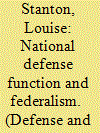

|
|
|
|
|
| Publication |
2012.
|
| Summary/Abstract |
Countries with a federalist system of government have different arrangements for providing national security. US national security is provided by national and State defense forces. The quintessential national function - national defense - experienced some changes that enhanced the role of the States. Policy changes in the National Defense Authorization Act of 2008 (2008 NDAA) introduced new roles for the Governors and the State defense forces, or the National Guard. This article explores how the interests of Congress and States aligned in the 2008 NDAA such that the national defense function changed. This article finds that the national government continues to have the central coordinating role, but that the politics and provisions of the 2008 NDAA changed the national-State relationship in mission, decision-making, and command and control so that US federalism in the national defense function is evolving in unexpected ways.
|
|
|
|
|
|
|
|
|
|
|
|
|
|
|
|
| 5 |
ID:
116065
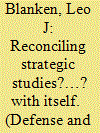

|
|
|
|
|
| Publication |
2012.
|
| Summary/Abstract |
Three distinct, and seemingly irreconcilable, schools of thought are identified within the strategic studies literature. One which searches for "universal principles of war," a second, "context-dependent," approach that seeks to embed each instance of warfare within its concurrent social, political, technological milieu and, finally a "paradoxical logic" school, which equates strategy with the generation of uncertainty. The author offers some intuitive concepts from non-cooperative game theory to develop a "dominate-mix" approach to strategy choice. In doing so, he helps to reconcile these disparate approaches and provides a simple framework to assist researchers in framing military decisions as well as to assist planners in choosing among strategies.
|
|
|
|
|
|
|
|
|
|
|
|
|
|
|
|
| 6 |
ID:
116070
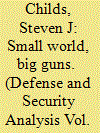

|
|
|
|
|
| Publication |
2012.
|
| Summary/Abstract |
With the burgeoning influence of emerging markets in Asia, a tectonic shift is taking place in the global security landscape. Asian states are concomitantly arming as their economic clout grows. In light of these developments, security analysts would benefit from a formal means of placing these arms acquisitions in a structural context. Are arms acquisitions on par with the expectations of Asian states, given their structural dispositions, or are recent acquisitions beyond anticipated levels? By using a dynamic panel regression of 187 states from 1950 to 2011, this research predicts arms import volume using the degree of interstate arms linkages, the size of a state's military, and its level of economic development. The technique offers analysts a formal means of distinguishing orthodox behavior in importing conventional weapons from extraneous security motivations. The article concludes by generating near-term forecasts of Asian arms imports and discussing the implications of the technique.
|
|
|
|
|
|
|
|
|
|
|
|
|
|
|
|
| 7 |
ID:
116069
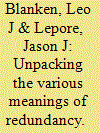

|
|
|
|
|
| Publication |
2012.
|
| Summary/Abstract |
The authors engage in the debate over waste in military force structure planning by rigorously deconstructing the concept of "redundancy." First, a typology of redundancy is constructed that provides a common framework for identifying variety among redundant structures. These are labeled "true redundancy," "expanded capacity," "portfolio diversification," and "mission overlap." Further, a number of mechanisms are identified that produce these types of structures, and show the conditions under which planners may utilize redundant structure in the search for optimization. In sum, the article provides refined concepts for analysts and planners to identify when redundancy is deleterious or beneficial.
|
|
|
|
|
|
|
|
|
|
|
|
|
|
|
|
|
|
|
|
|